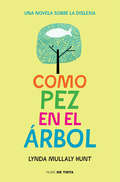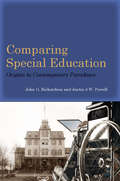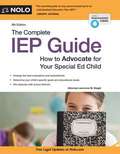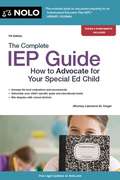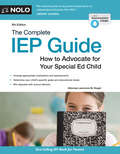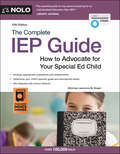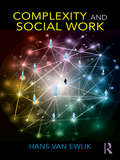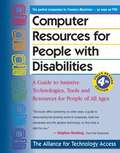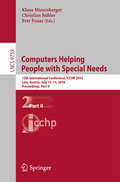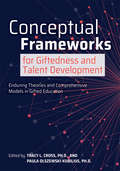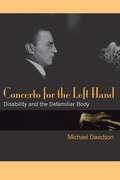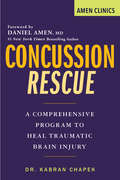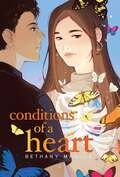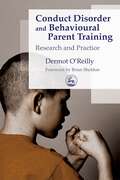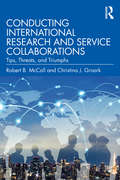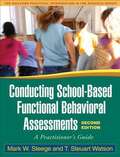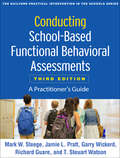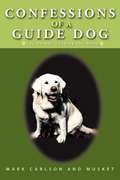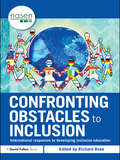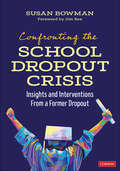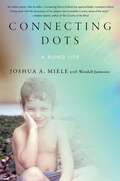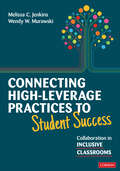- Table View
- List View
Como pez en el árbol: Una novela sobre la dislexia
by Lynda Mullaly HuntUna historia emotiva e inspiradora que llegará a todos aquellos que alguna vez han sentido que no encajaban. «Todos somos genios. Pero si juzgas a un pez por su habilidad paratrepar a los árboles, pasará toda su vida sintiéndose un estúpido.»Albert Einstein, disléxico Ally es una maestra en el arte del engaño. Cada vez que llega a un nuevo colegio, esconde su incapacidad de leer creando inteligentes pero extrañas distracciones a su alrededor. Tiene miedo de pedir ayuda. Y, además, ¿es que alguien puede curar la estupidez? Pero su nuevo profesor ha visto el brillo y la creatividad oculta tras su aire problemático. Con su ayuda, Ally aprenderá que la dislexia no es algo de lo que avergonzarse, mientras se abre ante ella un mundo lleno de posibilidades. Porque cada uno de nosotros llevamos un océano dentro, y las grandes mentes no suelen pensar como lo hacen los demás. La crítica ha dicho...«Conmovedora... Con el énfasis en "pensar de forma diferente". Los fans de R.J. Palacio apreciarán esta historia que ensalza el valor de la amistad y de la inteligencia no convencionales.»Kirkus Reviews «Una historia llena de personajes únicos dibujados con el corazón. Una novela sobre la dislexia, algo tan único como su heroína.»Booklist «Los lectores... adorarán a esta maravillosa protagonista.»The Horn Book
Comparing Special Education
by John G. Richardson Justin J. W. PowellIn today's schools the number of students who receive additional resources to access the curriculum is growing rapidly, and the ongoing expansion of special education is among the most significant worldwide educational developments of the past century. Yet even among developed democracies the range of access varies hugely, from one student in twenty to one student in three. In contemporary conflicts about educational standards and accountability, special education plays a key role as it draws the boundaries between exclusion and inclusion. Comparing Special Educationunites in-depth comparative and historical studies with analyses of global trends, with a particular focus on special and inclusive education in the United States, England, France, and Germany. The authors examine the causes and consequences of various institutional and organizational developments, illustrate differences in forms of educational governance and social policy priorities, and highlight the evolution of social logics from segregation of students with special educational needs to their inclusion in local schools.
Competency Based Curriculum for Teachers of the Visually Handicapped
by Susan J. SpunginThis book is a guideline for teachers of the blind. Six basic types of education system now exist, and were examined for the purposes of this study: full-time special class, resource room, itinerant program, resource room/itinerant program, teacher consultant, and residential school.
Complete IEP Guide, The
by Lawrence M. SiegelCreate an IEP with this start to finish guide for caring parents. Your special needs child needs a special education, and as a parent, you face a number of obstacles as you work with your school district to develop an Individual Education Plan (IEP). Lots of steps, complicated paperwork, and intimidating procedures may seem like too much to take on... ...but you can do it! Let The Complete IEP Guide guide you through this complex process with vital information, strategies, and the encouragement you need to secure your child's education. Get everything you need to: understand your child's rights untangle eligibility rules and assessments collect all school records draft goals and objectives pinpoint specific problems develop a blueprint of program and services research school programs and alternatives prepare for IEP meetings resolve disputes with your school district Whether you're new to the IEP process or entering it once again, this user friendly, plain English guide is your outline for an effective educational experience for your child. You'll get all the forms, sample letters, and resources that you could possibly need at any stage of the IEP process. This edition is completely updated to reflect the latest and major changes to federal regulations concerning your special education student, including details about your child's eligibility for special education services.
Complete IEP Guide, The
by Lawrence Siegel AttorneyCreate an IEP with this start-to-finish guide for caring parents Your special needs child needs a special education, and as a parent, you face a number of obstacles as you work with your school district to develop an Individual Education Plan (IEP) - lots of steps, complicated paperwork, and intimidating procedures may seem like too much to take on... ...but you can do it! Let The Complete IEP Guide guide you through this complex process with vital information, strategies, and the encouragement you need to secure your child's education. Get everything you need to: understand your child's rights untangle eligibility rules and assessments collect all school records draft goals and objectives pinpoint specific problems develop a blueprint of program and services research school programs and alternative prepare for IEP meetings resolve disputes with your school district Whether you're new to the IEP process or entering it once again, this user-friendly, plain English guide is your outline for an effective educational experience for your child. You'll get all the forms, sample letters, and resources that you could possibly need at any stage of the IEP process. The 7th edition is completely updated to reflect the latest -- and major -- changes to federal regulations concerning your special education student, including details about your child's eligibility for special education services.
Complete IEP Guide, The: How to Advocate for Your Special Ed Child
by Lawrence M. SiegelPut the law on your child's side Federal law guarantees every child a free, appropriate education, and the goal of the Individualized Education Program (IEP) is to assure that every child with special needs receives what the law promises. But if you have a special ed child, you know that your family must make sure the school follows through. This powerful book covers: eligibility rules and assessments working with outside experts developing your child's ideal educational program preparing for and attending IEP meetings develop a blueprint of program and services, and resolving disputes with school districts. Whether you're new to the IEP process or entering it once again, this user-friendly, plain English guide is your outline for an effective educational experience for your child. This edition of The Complete IEP Guide provides key forms, sample letters and resources you need at every stage of the IEP process. With it, you can make sure your child gets a good education—the education he or she deserves.
Complete IEP Guide, The: How to Advocate for Your Special Ed Child
by Lawrence M. SiegelRecipient of the 2017 BRONZE Winner for Education Award from Foreword Indies. Get the educational services and support your child deserves Federal law guarantees every child a free appropriate education, and the goal of the Individualized Education Program (IEP) is to assure that every child with special needs receives what the law promises. But if you have a special ed child, you know that your family must make sure the school follows through. This powerful book covers: eligibility rules and assessments working with outside experts developing your child's ideal educational program preparing for and attending IEP meetings, and resolving disputes with school districts. The 10th edition includes summaries of important court decisions, expanded information on independent evaluations and bullying, and additional real-life tips. It provides key forms, sample letters, and resources you need at every stage of the IEP process. With it, you can make sure your child gets a good education—the education he or she deserves. With downloadable forms, letters and resources inside. Includes IEP blueprint.
Complexity and Social Work
by Hans Van EwijkBeing socially competent is essential in late modern society. We expect people to find their own accommodation, partner, job, community and lifestyle and struggle to find answers for those who are not able or do not have the opportunity to achieve these things. By placing social complexity, social vulnerability and social efficacy within a framework of social policy and social practice, Complexity and Social Work argues that growing social complexity excludes more and more citizens from social participation. The book starts with exploring complexity, super-diversity, vulnerability and social efficacy. From there the book deals with the discourses of social policy, social work and social work research, pledging for social policy aiming at desired outcomes, for generic contextual social work, and for a research practice that recognises practical wisdom. Aimed at final year undergraduates, postgraduates, professionals, trainers and lecturers involved in social work, social policy, social care, mental health and allied fields who are committed to treating socially vulnerable people with respect and acceptance, this book, the first of its kind, offers new perspectives on social complexity for practice, theory and research in human services.
Composing Myself: A Journey through Post-Partum Depression
by Fiona ShawFollowing the birth of her second child the author was hospitalized for two months with a severe postpartum depression. She was treated with electroshock therapy which left her with large gaps in her short-term memory. In an effort to make sense of what had happened to her she set out to write about her own life. She further launched an exploration of the literature about post-partum depression, and interviewed other women who had experienced this frightening and little-understood illness.
Computer Resources for People with Disabilities
by Alliance for Technology AccessA resource for people with disabilities who want to improve their lives through the use of technology.
Computers Helping People with Special Needs: 15th International Conference, ICCHP 2016, Linz, Austria, July 13-15, 2016, Proceedings, Part II (Lecture Notes in Computer Science #9759)
by Klaus Miesenberger Christian Bühler Petr PenazThe introduction to the 1st International Conference on Computers for Han- cappedPersons(Vienna,1989)byAMinTjoa(UniversityofVienna)andRoland Wagner(UniversityofLinz)?nishedwiththefollowingmissionstatementonthe "Future Direction on Computers for Handicapped Persons": "The di'erent themes show that a lot of problems are solved by the usage of computer technology for helping handicapped persons, for instance for the blind and visually handicapped. A consequence of the discussed themes there are two directions which should be done in the next years. One direction is obvious. The tools must be improved and research and development work should be extended to all groups of handicapped (even if they are numerically not so large as for instancetheblindorvisuallyhandicappedpersons). Ontheothersideinthearea of social implications there is an increasing demand on social science studies on overall computer use among disabled persons. Because sources are in principle missing today about disabled persons work tasks, research in this ?eld must begin by trying to survey this aspect. Particular attention should be paid to the extent and character of computer use among the handicapped in work life. There are a lot of questions, which should be answered during the next years for reaching the aim of rehabilitation. " Fifteen years later the 9th International Conference on Computers Helping People with Special Needs (Paris, 2004) o'ered a comprehensive and deepened view on general awareness,special research and individual applications conce- ing disabled people and their participation in our society.
Conceptual Frameworks for Giftedness and Talent Development: Enduring Theories and Comprehensive Models in Gifted Education
by Paula Olszewski-Kubilius Tracy CrossConceptual Frameworks for Giftedness and Talent Development explores current and enduring theories and comprehensive models of giftedness and talent development. Each chapter:Includes a description of a different model, theory, or framework.Shares the most important implications of each model, including underrepresentation and social justice issues.Provides commentary on how each model compares to others.Includes discussion questions for use with students and professionals.The editors also consider common issues across conceptual frameworks, such as the degree to which achievement defines giftedness, the goal of gifted education, and the role of psychosocial factors. This is a comprehensive reference for scholars and practitioners in the field, as well as those studying at the graduate level.
Concerto for the Left Hand: Disability and the Defamiliar Body
by Michael DavidsonConcerto for the Left Hand is at the cutting edge of the expanding field of disability studies, offering a wide range of essays that investigate the impact of disability across various art forms---including literature, performance, photography, and film. Rather than simply focusing on the ways in which disabled persons are portrayed, Michael Davidson explores how the experience of disability shapes the work of artists and why disability serves as a vital lens through which to interpret modern culture. Covering an eclectic range of topics---from the phantom missing limb in film noir to the poetry of American Sign Language---this collection delivers a unique and engaging assessment of the interplay between disability and aesthetics. Written in a fluid, accessible style, Concerto for the Left Hand will appeal to both specialists and general audiences. With its interdisciplinary approach, this book should appeal not only to scholars of disability studies but to all those working in minority art, deaf studies, visual culture, and modernism. Michael Davidson is Professor of American Literature at the University of California, San Diego. His other books include Guys Like Us: Citing Masculinity in Cold War Poetics and Ghostlier Demarcations: Modern Poetry and the Material World.
Concussion Rescue: A Comprehensive Program to Heal Traumatic Brain Injury
by Kabran ChapekDaniel Amen and The Amen Clinics have become widely known and respected across America and internationally via television, print, and the online world reaching millions of viewers and consumers each year. We now have the wonderful opportunity to publish a line of health care books under the Amen Clinics imprimatur.#1 New York Times bestselling author, Daniel Amen, will write a foreword for each book and promote the book through all of his channels (mailing list, newsletter, social media). The first book we will be publishing is Concussion Rescue, which will give readers the natural and effective protocols for healing from traumatic brain injury.In Concussion Rescue, Dr. Kabran Chapek shares the programs and protocols that he uses at the Amen Clinics to put patients on the pathway to healing from traumatic brain injury. From general assessment using sophisticated tools (SPECT imaging, MRIs and CAT scans) to very specific blood tests (out-of-balance lab values in blood can point to symptoms of brain injury and may explain why the brain is not healing), Dr. Chapek guides readers to getting the proper medical care. He shares the cutting edge and most effective treatments for acute traumatic brain injury, as well as chronic traumatic brain injury, and provides the most powerful natural treatments including diet and supplements. Concussion Rescue will be an invaluable and potentially lifesaving resource for athletes, parents of student athletes, coaches, and anyone who suffers a mild or severe brain injury.
Conditions of a Heart
by Bethany MangleFor fans of Talia Hibbert and Lynn Painter comes a funny and unflinchingly honest story about a teen who must come to terms with her disability and what it means for her identity, her love life, and her future.Brynn Kwan is desperate for her high school persona to be real. That Brynn is head of the yearbook committee, the favorite for prom queen, and definitely not crumbling from a secret disability that&’s rapidly wearing her down. If no one knows the truth about her condition, Brynn doesn&’t have to worry about the pitying looks or accusations of being a faker that already destroyed her childhood friendships. She&’s even willing to let go of her four-year relationship with her first love, Oliver, rather than reveal that a necessary surgery was the reason she ignored his existence for the entire summer. But after Brynn tries to break up a fight at a pep rally and winds up barred from all her clubs and senior prom, she has nothing left to prop up her illusion of being just like everyone else. During a week-long suspension from school, she realizes that she doesn&’t quite recognize the face in the mirror—and it&’s not because of her black eye from the fight. With a healthy sister who simply doesn&’t understand and a confused ex-boyfriend who won&’t just take a hint and go away like a normal human being, Brynn begins to wonder if it&’s possible to reinvent her world by being the person she thought no one wanted: herself.
Conduct Disorder and Behavioural Parent Training: Research and Practice
by Dermot OreillyProgress made with children with conduct disorder in specialist schools often does not transfer to the home, but this book shows how behavioural parent training and applied behaviour analysis can help professionals work with parents to continue improving their child's behaviour. Conduct Disorder and Behavioural Parent Training provides a comprehensive introduction to the field of conduct disorder and the individual, familial and social factors that influence the development of persistent antisocial behaviour. The author presents thorough evidence for the effectiveness of the following aspects of behavioural parent training: * compliance training * encouraging good behaviour through praise, enthusiasm and attention * using `time out' as an effective punishment technique * transfer of improvements to school setting * effects of treatment on the child's siblings. He considers the relative impact and costs of different settings for parent training, and outlines ethical issues and future directions for research in this area. This book is essential reading for all professionals involved in the care of children with conduct disorder, as well as psychology and social work students and academics.
Conducting International Research and Service Collaborations: Tips, Threats, and Triumphs
by Robert B. McCall Christina J. GroarkConducting International Research and Service Collaborations: Tips, Threats, and Triumphs provides academic researchers, as well as non-profit and private professionals, with much-needed guidance on how to plan, implement, and manage international research and intervention projects. Accessibly written and illustrated throughout with examples and case studies of projects from Robert B. McCall and Christina J. Groark's wide-ranging and decades-long experience of cross-border collaborations, this book outlines how to prepare for and ensure success of cross-border research projects and interventions, how to embrace unique circumstances you may encounter, and what to do if things go wrong. Each chapter covers a general domain of concerns, advice, and lessons learned in conducting international collaborative projects followed by concrete illustrations that pertain to them. Key topics covered include launching projects and working with stakeholders, travelling and living abroad, cultural considerations, planning and funding, administrative issues, dealing with crises, and successfully implementing and disseminating findings effectively. This comprehensive guide is ideal for researchers and project managers – from large, global organizations to small NGOs, human services, private industry, and other fields embarking on such projects, as well as university students and academics.
Conducting School-Based Functional Behavioral Assessments, Second Edition
by T. Steuart Watson Mark SteegeExplaining the "whats," "whys," and "how-tos" of functional behavioral assessment, this practical and engaging book is packed with real-world tools and examples. Effective procedures are presented for evaluating challenging behavior in K 12 students, organizing assessment data, and using the results to craft individualized behavior support plans. The authors draw on extensive school-based experience to provide sample reports, decision trees, and reproducible checklists and forms all in a large-size format with lay-flat binding to facilitate photocopying. New to This Edition Revised throughout to reflect significant advances in the field. Provides an updated conceptual model for understanding behavior. Three new chapters cover brief functional analysis, behavior-analytic problem solving, and direct behavioral consultation. Fully updated coverage of legal issues under IDEIA. Includes revised forms and sample reports.
Conducting School-Based Functional Behavioral Assessments, Third Edition: A Practitioner's Guide (The Guilford Practical Intervention in the Schools Series)
by Richard Guare T. Steuart Watson Frank M. Gresham Mark W. Steege Jamie L. Pratt Garry WickerdWidely recognized as a gold-standard resource, this authoritative book has been revised and expanded with 50% new material. It provides a complete introduction to functional behavioral assessment (FBA), complete with procedures, forms, and tools that have been piloted and refined in both general and special education settings. Numerous vivid examples illustrate how to use the authors' behavior-analytic problem-solving model (BAPS) to synthesize assessment results and guide the design of individually tailored interventions. Practitioners and students enjoy the engaging, conversational tone. In a large-size format with lay-flat binding for easy photocopying, the book includes 17 reproducible checklists and forms. Purchasers get access to a companion Web page where they can download and print the reproducible materials. New to This Edition *Revised BAPS model reflects the latest research and offers a more comprehensive approach to FBA. *Chapters on professional and ethical standards; analyzing how biological/medical conditions, thoughts, and emotions influence behavior; and analyzing how executive skills deficits influence behavior. *Chapters on testing hypotheses about the functions of problem behavior; testing reinforcer effectiveness; and evaluating function-based interventions. *Chapter providing applied learning experiences for professionals and students. *Most of the reproducible tools are new or revised. This book is in The Guilford Practical Intervention in the Schools Series, edited by T. Chris Riley-Tillman.
Confessions of A Guide Dog: The Blonde Leading the Blind
by Mark Carlson MusketHave you ever wondered what a guide dog does? How do they know to lead a blind owner? Can they understand traffic lights? Most importantly, how does the owner know where to pick up the poop? This memoir answers these questions-and more. It tells what guide dogs are supposed to do. In this book, Mark and Musket tell their story with humor and emotion.
Confronting Obstacles to Inclusion: International Responses to Developing Inclusive Education (nasen spotlight)
by Richard RoseConfronting Obstacles to Inclusion uniquely and comprehensively addresses interpretations of inclusive education by drawing upon the experiences and expertise of leading writers and academics who have direct experience of teaching and researching this area around the world. This landmark publication combines theoretical chapters with practical material demonstrating how the theories can be put in to action in the classroom. The contributors, who all have regular contact with pupils and teachers in inclusive settings, provide a broad spectrum of ideas, examine a number of key themes and interpret these in an international context, such as: the causes of exclusion, the obstacles to inclusion and how these can be overcome supporting families how we can learn from students professional development enhancing teaching and learning support in the classroom. This authoritative text will be of immense interest and use to practitioners, policy-makers, researchers and campaigners who are working towards a more equitable and inclusive society. Through a synthesis of theory and practice the book offers readers an opportunity to explore local, national and international perspectives and raises questions with regards to our current understanding of inclusion. Whilst the interrogation of the concept of inclusion is, in itself important, the book provides examples of professional approaches to the key questions which are currently challenging the education of a diverse range of learners.
Confronting the School Dropout Crisis: Insights and Interventions From a Former Dropout
by Susan BowmanReach out before they drop out Student dropout rates continue to soar, despite decades of funding, research, programs, and professional development initiatives. This is a wakeup call. Written by a former school dropout, Confronting the School Dropout Crisis encourages educators and related professionals to discover and explore the sometimes unnoticed reasons that youth drop out of school. With fresh strategies for prevention and intervention, this critical resource includes: How to reach and recover students who are at risk of dropping out or who already have Clear, impactful strategies that better engage and positively impact students who are at risk Moving personal stories from teens and the author Confronting the School Dropout Crisis invites you to rethink how you address real dropout issues with young people and how to incorporate fresh approaches to better reach and positively impact these students and their caregivers—before it’s too late.
Confronting the School Dropout Crisis: Insights and Interventions From a Former Dropout
by Susan BowmanReach out before they drop out Student dropout rates continue to soar, despite decades of funding, research, programs, and professional development initiatives. This is a wakeup call. Written by a former school dropout, Confronting the School Dropout Crisis encourages educators and related professionals to discover and explore the sometimes unnoticed reasons that youth drop out of school. With fresh strategies for prevention and intervention, this critical resource includes: How to reach and recover students who are at risk of dropping out or who already have Clear, impactful strategies that better engage and positively impact students who are at risk Moving personal stories from teens and the author Confronting the School Dropout Crisis invites you to rethink how you address real dropout issues with young people and how to incorporate fresh approaches to better reach and positively impact these students and their caregivers—before it’s too late.
Connecting Dots: A Blind Life
by Joshua A. MieleIn this extraordinary memoir, a scientist who became blind at a young age shares how he navigates the world around him, and how his contributions led to cutting‑edge work in accessibility—packed with humor, adventure, and insights on life and disability. At the age of four, Joshua Miele was blinded and badly burned when a neighbor poured sulfuric acid over his head. It could have ended his life, but instead, Miele—naturally curious, and a born problem solver—not only recovered, but thrived. Throughout his life, Miele has found increasingly inventive ways to succeed in a world built for the sighted, and to help others to do the same. At first reluctant to even think of himself as blind, he eventually embraced his blindness and became a committed advocate for disability and accessibility. Along the way, he grappled with drugs and addiction, played bass in a rock band, worked for NASA, became a guerilla activist, and married the love of his life and had two children. He chronicles the evolution of a number of revolutionary accessible technologies and his role in shaping them, including screen readers, tactile maps, and audio description.Connecting Dots delivers a captivating first-person perspective on blindness and disability as incisive as it is entertaining, and ultimately triumphant. Joshua Miele's story is one of one ordinary blind life with an indelible impact.
Connecting High-Leverage Practices to Student Success: Collaboration in Inclusive Classrooms (The\norton Series On Inclusive Education For Students With Disabilities Ser. #0)
by Wendy Murawski Melissa JenkinsTransform classrooms and student performance with evidence-based, effective practices Two brains are better than one, as the saying goes, and this is especially true in education. Educators who employ effective collaboration and co-teaching greatly amplify student engagement, achievement, and growth, particularly for those learners needing extra support. Written by two of the nation’s top experts in co-teaching, Connecting High-Leverage Practices to Student Success is an essential, reader-friendly guide for educators and instructional leaders who are passionate about creating truly inclusive classrooms where all students thrive— academically, behaviorally, socially, and emotionally. Inside, authors Melissa Jenkins and Wendy Murawski provide: Three clearly defined steps to build a strong foundation, leverage collaboration, and support students’ growth A laser focus on high-leverage and evidence-based practices for general and special education that optimize educators’ impact, including collaboration, instruction, assessment, and social emotional/behavior skills Seamless integration of practices within MTSS and RTI processes to meet the needs of all learners Countless and concrete samples, examples, tools, reflection exercises, and supplemental materials that enable you to move from theory to immediate instructional practice Positioning collaboration as the catalyst to maximizing high-leverage and evidence-based practices for the success of all students, this easy-to-use handbook belongs on the desk of every teacher working toward a truly inclusive environment.
